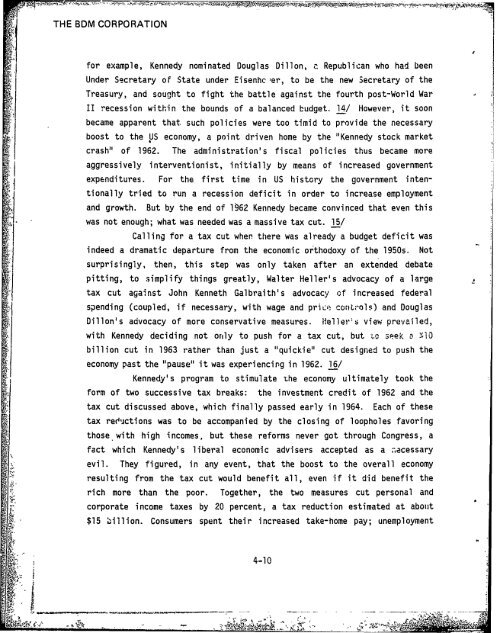policy - The Black Vault
policy - The Black Vault
policy - The Black Vault
Create successful ePaper yourself
Turn your PDF publications into a flip-book with our unique Google optimized e-Paper software.
THE BDM CORPORATION<br />
Itt<br />
for example,<br />
Kennedy nominated Douglas Dillon, c Republican who had been<br />
Under Secretary of State under Eisenhc ,er, to be the new Secretary of the<br />
Treasury, and sought to fight the battle against the fourth post-World War<br />
II recession within the bounds of a balanced budget. 14/ However,<br />
it soon<br />
became apparent that such policies were too timid to provide the necessary<br />
boost to the US economy, a point driven home by the "Kennedy stock market<br />
crash" of 1962. <strong>The</strong> administration's fiscal policies thus became more<br />
aggressively interventionist, initially by means of increased government<br />
expenditures. For the first time in US history the government intentionally<br />
tried to run a recession deficit in order to increase employment<br />
and growth. But by the end of 1962 Kennedy became convinced that even this<br />
- was not enough; what was needed was a massive tax cut. 15/<br />
Calling for a tax cut when there was already a budget deficit was<br />
indeed a dramatic departure from the economic orthodoxy of the 1950s. Not<br />
surprisingly, then, this step was only taken after an extended debate<br />
pitting, to simplify things greatly, Walter Heller's advocacy of a large<br />
tax cut against John Kenneth Galbraith's advocacy<br />
spending (coupled,<br />
of increased federal<br />
if necessary, with wage and pric'% cot)Lrols) and Douglas<br />
Dillon's advocacy of more conservative measures. Helier's view prevailed,<br />
with Kennedy deciding not only to push for a tax cut, but '.o seek e 1*H<br />
billion cut in 1963 rather than just a "quickie" cut designed to push the<br />
economy past the "pause" it was experiencing in 1962. 16/<br />
Kennedy's program to stimulate the economy ultimately took the<br />
form of two successive tax breaks: the investment credit of 1962 and the<br />
tax cut discussed above, which finally passed early in 1964.<br />
Each of these<br />
tax reductions was to be accompanied by the closing of loopholes favoring<br />
those with high incomes, but these reforms never got through Congress, a<br />
fact which Kennedy's liberal economic advisers accepted as a necessary<br />
evil. <strong>The</strong>y figured, in any event, that the boost to the overall economy<br />
resulting from the tax cut would benefit all, even if it did benefit the<br />
rich more than the poor. Together, the two measures cut personal and<br />
corporate income taxes by 20 percent, a tax reduction estimated at about<br />
$15 billion. Consumers spent their increased take-home pay; unemployment<br />
4-10
















